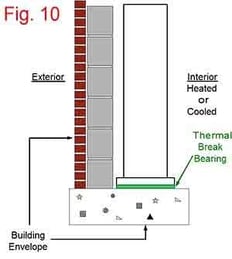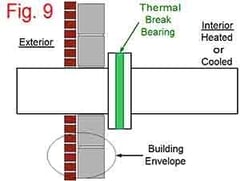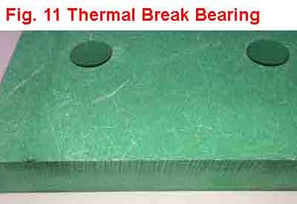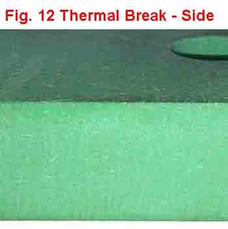Unlike any of the other bearings mentioned in this discussion, thermal break bearings are built to handle static loads only.
Their function is to interrupt “thermal bridging”, or the transfer of energy through steel members. They should be considered structural components and will usually be found between beams that connect through the building envelope, i.e. walls (Fig. 9) or under base plates. (Fig. 10).

As shown in these two illustrations, thermal break material requires very high compressive strength. Fig. 11 is a typical thermal break bearing. This piece is 12” x 10” x 1” thick and has a compressive strength of 48 ksi. To achieve that strength, the bearing is made of

a dense fiber reinforced resin. For the steel fabricator attempting to cut this material, the composition and density are essential to understand.
The density of thermal break material makes it much harder to cut than other bearing materials. If cut with a high speed rotational saw blade, or drilled the hardness and speed of the blade/bit, enough heat will be generated to destabilize the bearing. As the heat diffuses through the bearing material, it causes “radicalization”, or a separation of the fibers and resins. The result is a lowering of the compressive strength and a compromise in the ability to act as a structural component.
To properly fabricate bearings from thermal break stock material, all dimensions and holes should be done by a water jet cutter. This is a pressure stream of water carrying very fine garnet silicate which acts as the abrasive. The water, the propelant, has the side benefit of providing an endless stream of coolant and prohibits any heat from developing on the work surface. Immediately after cutting the workpiece, the surface is actually cool to the touch.
The cutting process goes beyond the simple propulsion of water carrying an abrasive. to properly fabricate thermal break bearings, the operator needs to understand the subject material and the effects of media type, hardness, size and shape, and water stream width and pressure, which can range from 30ksi to 90ksi.

With all these variables to consider, and the critical nature of the finished product in the structure, it is important to have these bearings done by an experienced thermal break operator who can fabricate accurately and maintain the integrity of the bearing.
Fig. 12 shows a side view of a bearing that has been properly cut.





